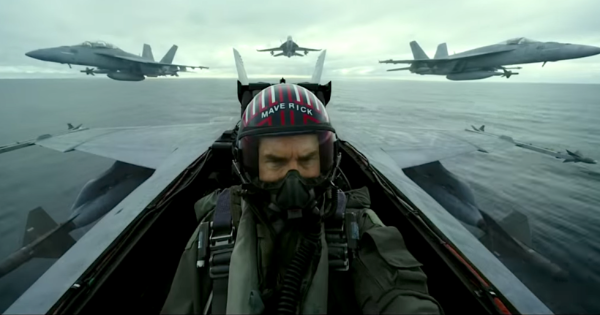

[shortcode-Op-Ed-disclosure]
The new trailer for Top Gun: Maverick was everything an aviator or wannabe aviator could hope for. I’m a sucker for a good military action movie as much as the next guy, so of course I’ll go see it. Even a longtime helicopter and tiltrotor pilot like me can appreciate that a Low Altitude Tactics (LAT) flight at 500 knots is pretty badass — and yes, even acknowledge that an F/A-18E Rhino might be almost as sexy as a V-22.
In 1986, Top Gun (or TOPGUN for purists) changed civilians’ whole perception of the military in general, and the Navy and naval aviation in particular. Applications for Annapolis skyrocketed. So did enlistments, along with buyer’s remorse when thousands of sailors realized the only need for speed they’d feel would be manning their brooms a little quicker during “sweepers.”
Top Gun: Maverick will probably be a very entertaining movie. While the Navy definitely would have shit-canned Mav years ago, Xenu has come through for him big time. Tom Cruise will be at his Cruisiest. But while popcorn sales will be through the roof in 2020, recruitment numbers won’t skyrocket like they did in 1986. In fact, I’d bet they won’t even budge.
The impact that Top Gun had on enlistment was unusual for one simple reason: there hadn’t been a big conflict since the end of the Vietnam War 13 years earlier. Despite all of the supposed belligerency of the Reagan era, the biggest fight of the era was 72 hours in Grenada, immortalized in the Clint Eastwood classic Heartbreak Ridge. As much as Top Gun s air-to-air engagements made fighter jocks seem like knights of the sky, the real action in the next major conflict, the 1991 Gulf War, involved mostly dropping bombs. Dogfighting is so rare today that a state-of-the-art F/A-18E splashing a museum-worthy SU-22 Fitter rates a Distinguished Flying Cross.
Against the backdrop of almost no actual fighting in the real world, the bloodless yet glamorous engagements of Top Gun were seductive, and signing up to work in naval aviation was a glamorous gateway to the amateur shirtless volleyball circuit. But n 1986, there weren’t multiple conflicts occurring simultaneously around the world, and while I don’t know the plot of Top Gun: Maverick yet, but I venture to say that the climax will not be a mission representative of 99.9% of modern American air warfare, where the danger of just landing the aircraft is greater than the danger posed by the enemy.
This isn’t an exaggeration. Today, the real nature of air warfare is readily apparent to anyone who cares. It’s making the doughnuts, except occasionally someone dies; it means going to sea for eight months and maybe getting to drop some ordnance if you’re lucky. Is Top Gun: Maverick going to feature a $70 million fighter dropping JDAMS on tribal gatherings in Yemen? Is Mav going to spend 3 hours performing duties as pretty much a manned UAV, recording the “pattern of life” of Afghan villagers with a targeting pod?
Funny how there aren’t so many takers — it’s gotten so bad that the Navy has to bribe fighter pilots up to $175K just to get them to stay and fly mach two with their hair on fire.
Movies and pop culture shape society, and even the military, more than many admit. In the absence of real conflict, Top Gun shaped its own narrative. It defined conflict on Hollywood’s terms. But after nearly two decades of conflict, even the dullest moviegoer knows that flying F/A-18s is more deliveryman than steely-eyed killer. High explosive deliveries to huts in the middle of nowhere may be tactically essential, but they aren’t the stuff of summer blockbusters.
During a time of peace, a movie glamorizing war drove recruitment through the roof. Unfortunately, in a time of war, movies glamorizing war don’t work as well. You can count the number of true war movies this year with one hand. All the big ones, Aftermath, The Last Full Measure, etc. are about wars from generations past.
Today’s wars don’t offer the simplicity and clear heroes and villains the medium requires. They’ve gone for 18 years, so it’s clear that no ending suitable for a movie climax is anywhere in sight. In today’s wars, the heroes aren’t pretty boys with spiked hair, but hard men with ridiculous beards.
[shortcode-Carl-Forsling-bio]